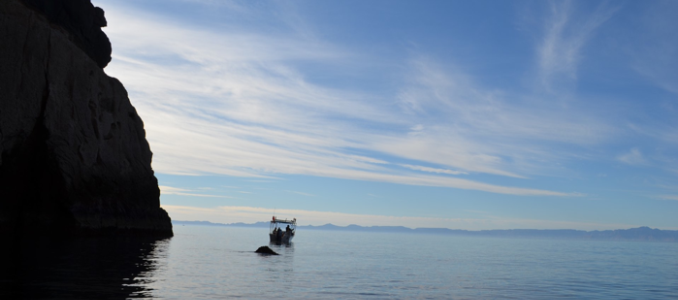A blueprint to guide managers as they integrate ocean tipping points into their decisionmaking

Big Picture
A conceptual framework “simplifies a system in a way that exposes the mechanistic relationships among components… and lends predictability to actions and reactions. It suggests what should be measured in order to characterize the system” (i.e., tipping point processes). Incorporating knowledge of ecosystem thresholds or tipping points into marine management decisions requires applying abstract ideas in complex and only partially-understood ecological settings. Building on our glossary that defines the key terms and concepts surrounding ecosystem thresholds (or tipping points) and indicators, we are producing a schematic that organizes and identifies the connections between the often abstract components of threshold processes and how they can be applied when implementing threshold-relevant management decisions. An accompanying guide to applying the framework will detail how to 1) characterize ecosystem states with a small number of key attributes, 2) define tipping points between these ecosystem states and 3) address the challenges of finding and monitoring leading indicators and defining management targets with reference to those tipping points. We are working closely with our scientific and management advisors to ensure our conceptual framework is relevant and flexible. We are implementing the framework for a small number of specific management challenges in our two case study locations, Hawai'i and Haida Gwaii.
Why we are doing it
We want managers to be able to identify and define the relevant/high priority thresholds in their system, know when they are approaching those tipping points, and how quickly they will have to take action to avoid crossing them. Our conceptual framework serves as a heuristic guide to achieving these goals that is general enough to apply across a diversity of ecosystems and management contexts, but yet specific enough to be useful in a real-world context. The conceptual framework is a blueprint to help managers apply the concepts behind the science of ecosystem tipping points.
How we are doing it
- We surveyed the literature for relevant examples of conceptual frameworks used to map out complex concepts and guide their management applications.
- Using our glossary, we identified the components of the conceptual framework.
- In our January 2013 all-hands working group, we began to sketch out the structure of the conceptual framework and hone our approach and objectives.
- We are using a variety of the ongoing project activities to enhance our understanding of the relationships among framework components and test generalities about indicators. This practical understanding is essential to developing implementation guidelines.
- Our scientific working group critiques and improves our conceptual framework.
- We are prototyping the conceptual framework in both case study locations and and further refining it based on its performance.
- We will publish our conceptual framework in the scientific literature and create a companion resource guide for managers.
What we are discovering
So far we have found that:
- There are several existing useful examples of conceptual frameworks related to characterizing ecosystem tipping points and managing for resilience, but none that are close to meeting our goals.
- Nonetheless, we can draw on established concepts of ecosystem tipping point behavior and approaches to setting indicators and targets as we develop our own customized conceptual framework to: operate within a resilience based management approach, avoid specific prescriptions for action, and incorporate a specific focus on non-linearities.
We held a 3 day intensive workshop in November 2013 and again in June 2014 with our scientific working group to present our nascent conceptual framework and make progress toward finalizing it.
Outcome
Our conceptual framework should become a well-used tool that helps a wide audience understand the concepts behind our work and catalyzes the application of scientific theory on ecological thresholds to real world management challenges.
Building Blocks
The conceptual framework is a “living document .” It will evolve over time as it incorporates and synthesizes many of the insights gained in all of the other research activities, and its effectiveness will serve as a metric of project success. Its iterations will culminate in producing a capstone to our research program.
Lead
Kim Selkoe and the Scientific Working Group
Anticipated Completion
Spring 2016
Learn more about our other Research Activities with the Ocean Tipping Points project.
